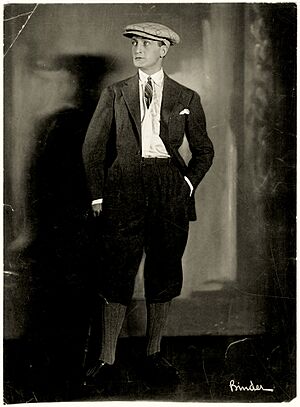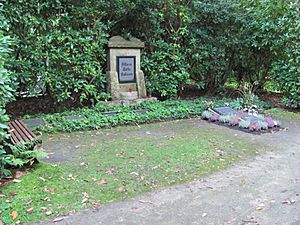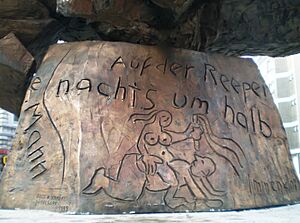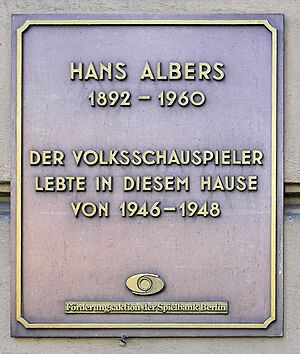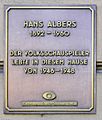Hans Albers facts for kids
Hans Philipp August Albers (born September 22, 1891 – died July 24, 1960) was a very famous German actor and singer. He was the biggest male movie star in Germany for many years, from 1930 to 1960. He is still remembered as one of the most popular German actors of the 20th century.
Contents
Early Life and Rise to Fame
Hans Albers was born in Hamburg, a big city in Germany. His father was a butcher. From a young age, Hans was very interested in acting. He secretly took acting classes when he was a teenager.
In 1915, during World War I, Hans Albers joined the German Army. He was wounded early in the war. After recovering, he started performing in plays, comedies, and musicals.
After the war, Albers moved to Berlin. There, he became a well-known comedic actor in many theaters. His big break came when he played a waiter in a play called Verbrecher (which means "Criminals"). In Berlin, he also met and started a long-term relationship with the actress Hansi Burg. They stayed together until he passed away in 1960.
Hans Albers acted in over 100 silent films. Then, in 1929, he starred in Germany's first "talkie" (a movie with sound) called Die Nacht gehört uns. Soon after, he appeared with the famous actress Marlene Dietrich in the classic movie Der blaue Engel.
Albers became a huge star in 1930 with the movie The Copper. He became known for playing brave, daring characters. He was especially good when he worked with another German movie legend, Heinz Rühmann. They starred together in films like Bombs on Monte Carlo (1931) and Der Mann, der Sherlock Holmes war (1937). Many of the songs Hans Albers sang in his movies became very popular and are still loved today.
Life During World War II
When the Nazis came to power in Germany in 1933, Hans Albers and his girlfriend, Hansi Burg, moved to Lake Starnberg in Bavaria. Hansi Burg was Jewish. Even though Albers never publicly supported the Nazi government, he became the most popular actor during their rule.
The Nazis usually didn't like relationships between non-Jewish and Jewish people. But because Hans Albers was so popular, they allowed his relationship with Hansi Burg for a long time. Eventually, the pressure became too much. Hansi Burg moved to Switzerland and then to Great Britain in 1939. However, they secretly remained a couple. Hans Albers even managed to send her money to help her. They were reunited after the war when she returned to Germany.
In 1943, Albers was paid a lot of money to star in a big movie called Münchhausen. This film was made to celebrate the UFA film studio's anniversary. Albers was careful not to seem like he was supporting the Nazi government, and he was never asked to. Also in 1943, he starred in another famous German film, Große Freiheit Nr. 7, with actress Ilse Werner. Some parts of this movie were filmed in Prague because Hamburg had been damaged by bombs.
After World War II
After World War II, Hans Albers was still wealthy. Because of his relationship with Hansi Burg, he didn't face the same problems that many other actors did. Some actors were not allowed to work because of their connections to the Nazi government.
However, the new government wanted to promote different stars. This meant Hans Albers had a break in his career. He later found new roles playing wise, older characters. He was still popular, but he never reached the same level of huge stardom he had in the 1930s and early 1940s. By the early 1950s, he was getting older, and his strong presence in films started to fade. Still, he continued to act in movies until the very end of his life.
Death
Hans Albers collapsed during a theater show because of serious internal bleeding. He passed away three months later, on July 24, 1960, at a hospital near Lake Starnberg. He was 68 years old. He was buried in the Ohlsdorf Cemetery in Hamburg, the city where he was born.
Legacy
Hans Albers' name will always be connected to his hometown of Hamburg. Especially the St. Pauli district, where a square is named Hans-Albers-Platz in his honor. Today, he is perhaps even better known for his music than his movies. Many of his songs are still familiar to young German people.
Outside of Northern Europe, Albers is not as well-known. However, the image of an older man in a sailor's cap and raincoat, playing an accordion and singing, is recognized internationally. For example, McDonald's used a similar image in an American TV ad in 1986. Even though he often played sailors, Albers actually didn't have much experience on the water!
Many of Albers' songs were funny stories about sailors on shore leave. They often included phrases from Low German, a dialect spoken in Northern Germany. One of his most famous songs is Auf der Reeperbahn nachts um halb eins ("On the Reeperbahn at Half Past Midnight"). This song has become one of the most famous songs about Hamburg and an unofficial anthem for the St. Pauli district. The Hans-Albers-Platz, near the Reeperbahn, has a statue of Albers created by the German artist Jörg Immendorff.
Songs (selection)
Here are some of Hans Albers' most famous songs:
- 1931: Das ist die Liebe der Matrosen (from the movie Bomben auf Monte Carlo)
- 1931: Kind, du brauchst nicht weinen (from the movie Der Draufgänger)
- 1932: Flieger, grüß' mit mir die Sonne (from the movie F. P. 1 antwortet nicht)
- 1932: Hoppla, jetzt komm' ich (from the movie Der Sieger)
- 1932: Komm' auf die Schaukel, Luise (from the play Liliom)
- 1932: Komm und spiel mit mir (from the movie Quick)
- 1933: "Mein Gorilla hat 'ne Villa im Zoo" (from the movie Today Is the Day)
- 1936: "In meinem Herzen Schatz, da ist für viele Platz" (from the movie Savoy-Hotel 217)
- 1937: "Jawohl, meine Herrn" (with Heinz Rühmann, from the movie Der Mann, der Sherlock Holmes war)
- 1939: "Good bye, Jonny" (from the movie Wasser für Canitoga)
- 1944: "La Paloma" (from the movie Große Freiheit Nr. 7)
- 1944: "Auf der Reeperbahn nachts um halb eins" (from the movie Große Freiheit Nr. 7)
- 1952: "Kleine weiße Möwe" (from the movie Käpt'n Bay-Bay)
- 1952: "Nimm mich mit, Kapitän, auf die Reise" (from the movie Käpt'n Bay-Bay)
- 1954: "Auf der Reeperbahn nachts um halb eins" (from the movie Auf der Reeperbahn nachts um halb eins)
- 1954: "Komm auf die Schaukel, Luise" (from the movie Auf der Reeperbahn nachts um halb eins)
- 1957: "Das Herz von St. Pauli" (from the movie Das Herz von St. Pauli)
- 1959: "Mein Junge, halt die Füße still" (from the movie Dreizehn alte Esel)
Images for kids
See also
 In Spanish: Hans Albers para niños
In Spanish: Hans Albers para niños



